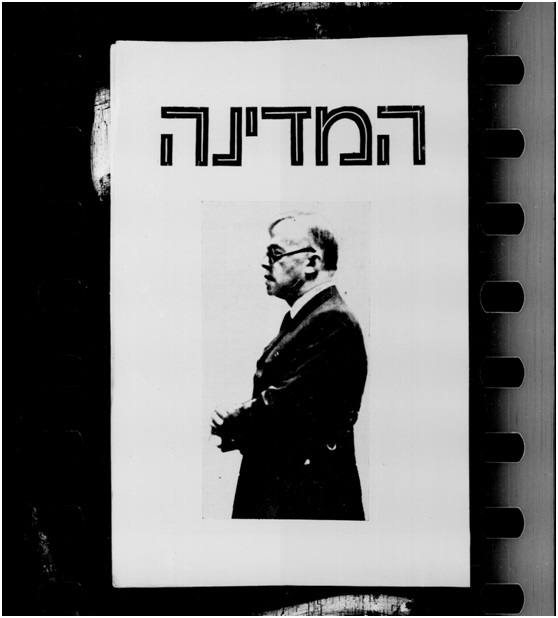
Hamedina (The State) published by the Betar Youth Movement, August 1940
Established by the occupying Germans in October 1940, the Warsaw ghetto was the largest of its kind during WWII, with some 450,000 Jewish men, women and children incarcerated there at its peak in extremely overcrowded and unsanitary conditions. Within the ghetto, their lives oscillated in the desperate struggle between survival and death from disease or starvation. Yet the walls of the ghetto and the guards surrounding them could not silence the educational, religious and cultural activity of its inhabitants, and despite the appalling living conditions, artists and intellectuals continued their creative endeavors. In the ghetto there were underground libraries, an underground archive, youth movements and even a symphony orchestra. There were schools and religious institutions, hospitals, theaters, cafes and newspapers.
The press was a critical tool used in the ghetto to spread important information about the outside world that was denied to the ghetto inhabitants. For the past decade, Yad Vashem has been working on the English version of its monumental research project ”The Jewish Underground Press in Warsaw" – a comprehensive and critical look at the range of Jewish newspapers and bulletins produced and circulated in the ghetto, at great danger to anyone who participated in doing so. The broad footnotes provide a deep insight into the characters, events and literary citations mentioned in the press, and bring the hopes, dreams and fears of the authors to life.
As the third (and so far, final) volume reaches its final stages before print, Dr. Tikva Fatal-Knaani, the Academic Editor of the series, gives us a fascinating overview of the project's history, goals and discoveries. It will presented in a three-part series.
PART ONE
What did the editors of this series, which came out in Hebrew in the 1980s, wish to show to the world when they decided to publish the Jewish Underground Press in the Warsaw ghetto during the Holocaust?
The idea of somehow publicizing the Jewish Underground Press in Warsaw arose shortly after the "Oneg Shabbos" underground archive was discovered in September 1946. Hidden in 10 metal casings that were buried under a house, these documents, testimonies, photographs and artworks, created in real time during the war, represent one of the largest Jewish archive collections from the Holocaust and gives the world a unique look into Jewish life in the Warsaw ghetto.
In January 1954, after Yad Vashem was established, work began to decipher the microfilms of the underground newspapers found in the archive. This was very challenging due to the damage to many of the volumes, making them practically unreadable – and the hunt began for copies from other sources and institutions worldwide.
The publication by Yad Vashem of the underground press first and foremost was intended to commemorate the Jewish spiritual-emotional world – and the intellectual battle – of the underground members from all ideological streams, political parties and youth movements. Even within the ghetto walls, the Jewish will was not broken, and under the constant threat of death they advocated for life and fought to instill their world with historical, cultural and social values.
At a time when the Nazi enemy did all they could to destroy both the life and soul of the Jewish people, the members of the underground called on their brothers and sisters to preserve their human spirit, and educated the youth towards national pride and faith in the eternal existence of the Jewish people.
Why was it decided to translate the series into English?
We felt it was essential to make the underground press accessible to an English-speaking audience. It is a tremendously useful tool for researchers both in Israel and abroad, whose numbers have grown greatly in recent decades, especially in Europe and the US. Much research relied, and still relies, on the underground press, because it has an inexhaustible treasure of areas of reference to life in the days of the Nazi occupation, the vision of the war and its consequences, ideological debates, sharp criticism of the Jewish establishment, concern for the youth in terms of values and morals, and more. Therefore, it is only logical to make the Jewish Underground Press accessible to the research community in particular and to the public interested in the life of the Jews during these years in general.
Who were the writers and editors of this press? What was their purpose when they (secretly) published the newspapers?
The Jewish Underground Press was a large-scale enterprise of all political movements, parties and youth movements, which were a real force on the Jewish street during the occupation. Among them were the heads of the parties and movements, writers and journalists: the General Zionists, the Communists and the Trotskyists. After organizing to address the immediate needs of the ghetto inhabitants, namely social assistance programs, such as charity funds and soup kitchens, the parties and youth movements resumed their partisan activities, turning to cultural and educational activities.
One of the manifestations of the renewal of inner life was the publication of the Jewish press. This press was published in the years 1940-1944 in the form of bulletins, magazines, periodicals and flyers. In this respect, it played an important role in the public and spiritual life of the Jews of Warsaw. The creators of the underground press fought to correct injustices, and presented the Jewish public with a purpose and content for its existence. Jewish public activists sought to provide reliable knowledge of what was happening both related to the war as well as news from the free world, because they were cut off from sources of information in the face of the ban on bringing newspapers from abroad into occupied Poland. The Jews did not receive information either about the general situation in Europe or about the occupier's directives that were imposed on them and affected their lives. For example, Gazeta Żydowska (Jewish Newspaper), published in the mid-1940s by the German authorities in the Generalgovernment, was intended to inform Jews of the occupier's orders, but at the same time it served as an instrument for deceiving the Jewish public about its true intentions.
The interview with Dr. Tikva Fatal-Knaani will continue in Part Two of this three-part series.
The Jewish Underground Press in Warsaw: Volume One - May 1940–January 1941 is available for purchase in our online store.











